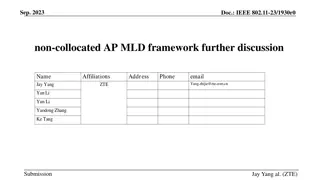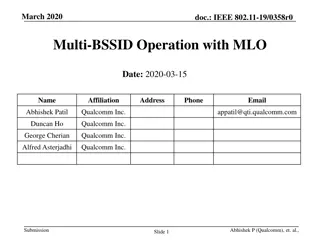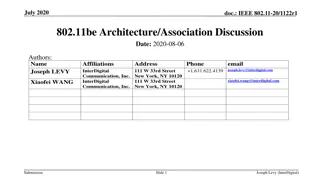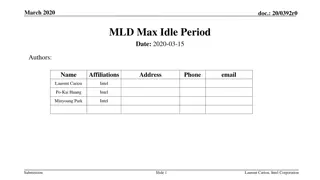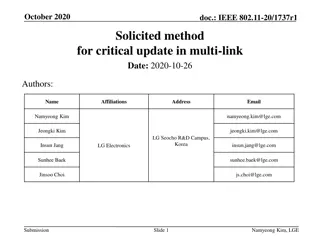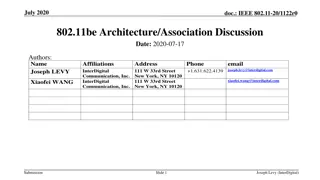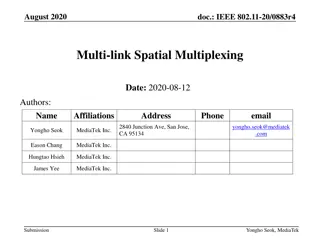
IEEE 802.11-20/0972r0 Multi-link Operation for Constrained MLD
Explore the proposal for a Notice-to-Send (NTS) mechanism in the context of Constrained Multi-link Operation in IEEE 802.11-20/0972r0. This mechanism aims to enhance data transmission efficiency by avoiding simultaneous transmission and reception on a pair of links, reducing overhead and access delay. Learn about the implications for multi-link channel access and the overhead caused by traditional RTS/CTS mechanisms.
Download Presentation

Please find below an Image/Link to download the presentation.
The content on the website is provided AS IS for your information and personal use only. It may not be sold, licensed, or shared on other websites without obtaining consent from the author. If you encounter any issues during the download, it is possible that the publisher has removed the file from their server.
You are allowed to download the files provided on this website for personal or commercial use, subject to the condition that they are used lawfully. All files are the property of their respective owners.
The content on the website is provided AS IS for your information and personal use only. It may not be sold, licensed, or shared on other websites without obtaining consent from the author.
E N D
Presentation Transcript
2020 doc.: IEEE 802.11-20/0972r0 Multi-link Operation for Constrained MLD Date: 2020-06-28 Authors: Name Affiliation Address Phone Email Liuming Lu ZTE Corporation No.889 Bibo Road, Shanghai, P.R.China lu.liuming@zte.com.cn Liquan Yuan ZTE Corporation No.889 Bibo Road, Shanghai, P.R.China yuan.liquan@zte.com.cn Submission 1 Liuming Lu, etc, ZTE
2020 doc.: IEEE 802.11-20/0972r0 Introduction A constrained MLD refers to the MLD which has constraints to simultaneously transmit and receive on a pair of links to operate over this pair of links. RTS/CTS mechanism has been proposed to avoid the simultaneous transmission and reception on a pair of links for the constrained MLD in some contributions, such as [1]. The usage of frequent RTS/CTS in frame exchange would increase the overhead of data transmission, and increase the access delay at the same time. This contribution proposes a mechanism of notice-to-send (NTS) for Constrained Multi-link Operation, which can not only avoid the simultaneous transmission and reception on a pair of links for the constrained MLD, but also decrease the overhead and access delay of data transmission. Submission 2 Liuming Lu, etc, ZTE
2020 doc.: IEEE 802.11-20/0972r0 Background Current 802.11be Specification Framework Document [2] has included some passed straw polls related to multi-link channel access for constrained MLD, showed in the following 1. 802.11be shall allow a MLD that has constraints to simultaneously transmit and receive on a pair of links to operate over this pair of links. Signaling of these constraints is TBD. 2. 802.11be supports the following cases in R1: STR AP MLD with STR non-AP MLD STR AP MLD with non-STR non-AP MLD Note: All the other cases are TBD. 3. 802.11be supports the following constrained multi-link operation: When a STA in a non-STR MLD receives an RTS addressed to itself, if the NAV of the STA indicates idle but another STA in the same MLD is either a TXOP holder or a TXOP responder, the STA may not respond with a CTS frame. Submission 3 Liuming Lu, etc, ZTE
2020 doc.: IEEE 802.11-20/0972r0 Overhead caused by RTS/CTS RTS/CTS would occupy the media time including the transmission of RTS and CTS frames and two SIFS, and affect the efficiency of data transmission, especially when the data PPDU has small size. Figure : RTS/CTS/data/Ack and NAV setting [3] Submission 4 Liuming Lu, etc, ZTE
2020 doc.: IEEE 802.11-20/0972r0 Notice-to-Send (NTS) Mechanism for the constrained MLD For the frame exchange between a STA in a constrained MLD and the other STA in a constrained or non-constrained MLD, when a STA gains the TXOP and gets ready to send MPDU a Notice-to- Send (NTS) frame should be sent before the transmission of MPDU. During the xIFS time slot after the transmission of the NTS frame according to the frames received by the STA(TXOP holder) and the other STAs affiliated with the same MLD the STA would determine whether to send the MPDU in order to avoid that the simultaneous transmission and reception on a pair of links for the constrained MLD occurs. Submission 5 Liuming Lu, etc, ZTE
2020 doc.: IEEE 802.11-20/0972r0 Notice-to-Send (NTS) Mechanism for the constrained MLD Case I: the STA(TXOP holder) is affiliated with the constrained MLD STA1 and STA2 are affiliated with a constrained MLD, and STA3 and STA4 are affiliated with a STR MLD. when STA1 obtains the TXOP and gets ready to send MPDU it sends a Notice-to- Send (NTS) frame before the transmission of MPDU. STA3 receives the NTS frame and knows that STA1 has obtained the TXOP, then it would indicate STA4 not to send frame to STA2 during the time period of TXOP. if STA2 receives no frame addressed to itself during the xIFS time slot after the transmission of the NTS frame STA1 sends MPDU to STA3. TXOP MLD 2 (non-STR) MLD 1 SF-IFS xIFS A-MPDU A-MPDU STA3 STA1 notice-to-send Short Frame STA4 STA2 The transmission from STA4 to STA2 is not allowed Submission
2020 doc.: IEEE 802.11-20/0972r0 Notice-to-Send (NTS) Mechanism for the constrained MLD Case I: the STA(TXOP holder) is affiliated with the constrained MLD STA1 and STA2 are affiliated with a constrained MLD, and STA3 and STA4 are affiliated with a STR MLD. when STA1 obtains the TXOP and gets ready to send MPDU it sends a Notice-to- Send (NTS) frame before the transmission of MPDU. STA3 receives the NTS frame and knows that STA1 has obtained the TXOP, but STA4 has sent another NTS frame. if STA2 receives the NTS frame or MPDU addressed to itself during the xIFS time slot after the transmission of the NTS frame STA1 stops sending MPDU to STA3. TXOP MLD 2 (non-STR) MLD 1 SF- IFS A-MPDU STA3 STA1 The transmission from STA1 to STA3 is not allowed notice-to-send Short Frame STA4 STA2 The transmission from STA4 to STA2 is not allowed A-MPDU Submission
2020 doc.: IEEE 802.11-20/0972r0 Notice-to-Send (NTS) Mechanism for the constrained MLD Case II: the STA(TXOP responder) is affiliated with the constrained MLD STA1 and STA2 are affiliated with a STR MLD, and STA3 and STA4 are affiliated with a constrained MLD. when STA1 obtains the TXOP and gets ready to send MPDU it sends a Notice-to- Send (NTS) frame before the transmission of MPDU. STA3 receives the NTS frame and knows that STA1 has obtained the TXOP, then it would indicate STA4 not to send frame during the time period of TXOP. if STA2 receives no frame sourced from STA4 during the xIFS time slot after the transmission of the NTS frame STA1 sends MPDU to STA3. TXOP MLD 1 (non-STR) MLD 2 SF-IFS xIFS A-MPDU A-MPDU STA3 STA1 notice-to-send Short Frame STA4 STA2 The transmission from STA4 to STA2 is not allowed Submission
2020 doc.: IEEE 802.11-20/0972r0 Notice-to-Send (NTS) Mechanism for the constrained MLD Case II: the STA(TXOP responder) is affiliated with the constrained MLD STA1 and STA2 are affiliated with a STR MLD, and STA3 and STA4 are affiliated with a constrained MLD. when STA1 obtains the TXOP and gets ready to send MPDU it sends a Notice-to- Send (NTS) frame before the transmission of MPDU. STA3 receives the NTS frame and knows that STA1 has obtained the TXOP, but STA4 has sent another NTS frame. if STA2 receives the NTS frame soured from STA4 during the xIFS time slot after the transmission of the NTS frame STA1 stops sending MPDU to STA3. TXOP MLD 2 MLD 1 (non-STR) SF- IFS A-MPDU STA3 STA1 The transmission from STA1 to STA3 is not allowed notice-to-send Short Frame STA4 STA2 The transmission from STA4 to STA2 is not allowed A-MPDU Submission
2020 doc.: IEEE 802.11-20/0972r0 Proposal This contribution proposes to add Notice-to-Send (NTS) Mechanism for the constrained MLD in Multi-link operation. For the frame exchange between a STA in a constrained MLD and the other STA in a constrained or non-constrained MLD, when a STA gains the TXOP and gets ready to send MPDU a Notice-to-Send (NTS) frame should be sent before the transmission of MPDU. During the xIFS time slot after the transmission of the NTS frame according to the frames received by the STA(TXOP holder) and the other STAs affiliated with the same MLD the STA would determine whether to send the MPDU in order to avoid that the simultaneous transmission and reception on a pair of links for the constrained MLD occurs. Submission . 10 Liuming Lu, etc, ZTE
2020 doc.: IEEE 802.11-20/0972r0 Conclusion This contribution proposes a mechanism of notice-to-send (NTS) for Constrained Multi-link Operation, which can not only avoid the simultaneous transmission and reception on a pair of links for the constrained MLD, but also decrease the overhead and access delay of the data transmission compared with the RTS/CTS mechanism. Submission 11 Liuming Lu, etc, ZTE
2020 doc.: IEEE 802.11-20/0972r0 Straw Poll 1 Do you support that a Notice-to-Send (NTS) Mechanism for Constrained Multi-link Operation are added in 802.11be? For the frame exchange between a STA in a constrained MLD and the other STA in a constrained or non-constrained MLD, when a STA gains the TXOP and gets ready to send MPDU a Notice-to-Send (NTS) frame should be sent before the transmission of MPDU. During the xIFS time slot after the transmission of the NTS frame according to the frames received by the STA(TXOP holder) and the other STAs affiliated with the same MLD the STA would determine whether to send the MPDU in order to avoid that the simultaneous transmission and reception on a pair of links for the constrained MLD occurs. Note: the format of NTS frame and xIFS is TBD. Submission 12 Liuming Lu, etc, ZTE
2020 doc.: IEEE 802.11-20/0972r0 References 1. 11-19-1959-01-00be-constrained-multi-link-operation 2. 11-20-0566-34-00be-compendium-of-straw-polls-and-potential-changes- to-the-specification-framework-document 3. IEEE 802.11 Standard - 2016 Submission 13 Liuming Lu, etc, ZTE
2020 doc.: IEEE 802.11-20/0972r0 Thank you! Submission 14 Liuming Lu, etc, ZTE

